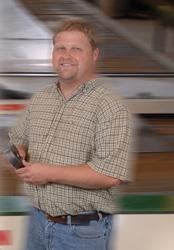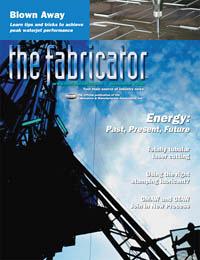- FMA
- The Fabricator
- FABTECH
- Canadian Metalworking
Categories
- Additive Manufacturing
- Aluminum Welding
- Arc Welding
- Assembly and Joining
- Automation and Robotics
- Bending and Forming
- Consumables
- Cutting and Weld Prep
- Electric Vehicles
- En Español
- Finishing
- Hydroforming
- Laser Cutting
- Laser Welding
- Machining
- Manufacturing Software
- Materials Handling
- Metals/Materials
- Oxyfuel Cutting
- Plasma Cutting
- Power Tools
- Punching and Other Holemaking
- Roll Forming
- Safety
- Sawing
- Shearing
- Shop Management
- Testing and Measuring
- Tube and Pipe Fabrication
- Tube and Pipe Production
- Waterjet Cutting
Industry Directory
Webcasts
Podcasts
FAB 40
Advertise
Subscribe
Account Login
Search
Better cuts with plasma
High-density plasma cutting equipment opens new doors for industrial contractor
- By Eric Lundin
- November 7, 2006
- Article
- Plasma Cutting
The cutting torch on the VICON Elite plasma cutting system travels 1,500 to 2,000 IPM when cutting thin- gauge steel sheet.
One job, that's all it took to change the fortunes of one company. Keller & Son Industrial Contractors Inc., Spartanburg, S.C., used to work out of a 5,000-square-foot facility with three employees and spent most of its time performing millwright and plant relocation work. Then came an order for metal fabrications that had to be delivered in three months.
The company needed a system that was accurate, offered high repeatability, and was powerful enough to cut mild steel up to 2 inches thick. Management also wanted a system that was easy to program and operate, requiring a minimal amount of training to do both.
Keller & Son found its answer with a familiar technology upgraded for more precise cuts.
Plasma Pleases Company
After much research, the company decided on the Plasma Automation VICON 2001 plasma cutting system with an Innerlogic® 200-amp, high-density plasma power supply and ViSoft cutting system software. In 2002 the system was delivered within nine weeks and was running in less than three days.
Trent Keller, the company's vice president, said the plasma cutting equipment purchase made sense because the technology had been used by Keller & Son operators in the past. In addition, Keller said he viewed the plasma cutting's operating costs as reasonable, especially given that the machine could run for years without the need for expensive overhauls or replacement parts. The new twist to this familiar technology, however, was the technology's ability to deliver precise cuts.
"We have realized a tremendous increase in part accuracy and repeatability with the VICON 2001 as compared to our original plasma cutting system," Keller said. "We can match a part from today's run to another processed yesterday, and they are absolutely identical. We have achieved a level of tolerance that we never expected."
On its original machine, a conventional plasma cutting system, Keller & Son typically achieved accuracy of ± 1/8 in. on most materials. On its high-density VICON machine, operators cut 1.5-in. plate within a tolerance of 1/32 in. or better at a cutting speed of 28 IPM.
"We could achieve even greater tolerances, but this is very good for processing material of this thickness at this speed," Keller said.
This precise cutting is especially important when delivering fabrications to its machine shop customers, Keller said. The parts need to be highly accurate and similar from one job to another so that the performance of the high-end machining centers won't be affected.
In response to demand for more capacity, Keller & Son purchased a second machine in January 2006. This was a VICON Elite plasma cutting system with a 10-ft.-wide by 20-ft.-long cutting table and an Innerlogic 260-amp, high-density plasma power supply. By this time the equipment was delivered to a 100,000-sq.-ft. facility, where 40 employees work seven days a week to meet customers' demands for its metal fabrications.

In addition to industrial contract work, the company builds products such as portable rubble screens at a rate of two per week. The massive 10-ton unit, made out of 10-ga. and 1-in. carbon steel, is designed for sifting dirt, gravel, and stone.
Something a Little Different
Most of the tables Keller encountered before its latest purchase were 8 ft. wide. The capability to process 10-ft. by 22-ft. sheet metal is a nice way for the company to stand out among the competition.
"We are the only manufacturer within a 100-mile radius with such a wide cutting area. Our customers are continually amazed when they see it," Keller said.
Keller said the larger table offers processing flexibility and the productivity advantages of a shuttle table because two standard-sized sheets of material can be placed on the machine simultaneously. After the first sheet is finished being processed, the gantry quickly moves the plasma cutting torch to the opposite end of the table to cut the second piece of material. The operator is then free to unload the finished parts while the machine is still processing.
"We have far more production time with this machine. It has been a real asset," Keller said.
It used to take a full day for Keller & Son to build one structural wall, commonly referred to as a side plate, for its mining industry customers. Now the company builds three to four walls per day.
"We are more competitive and efficient than ever before," Keller said.
Added Benefits
The new machine with its higher amperage allows Keller & Son to pierce materials up to 1 to 1.25 in. thick on-the-fly.
"On our original plasma table, if we needed to cut a hole in the center of a piece of plate material, we would have to lead into the hole from the edge, or we would have to use a drill bit to predrill 50 percent of the hole before processing," Keller said. "Now we burn multiple holes easily, quickly, and accurately."
What about part quality? Keller reached for a part recently cut from 1.25-in. mild steel to answer the question.
"This part has come straight off of our table without refinishing. Not only is it accurate, but the edges are smooth without a drop of dross. Nine times out of 10, the parts that come off of our table look this way," he said.
"Customers today are not only looking for tight tolerance and fast turnaround, but they also want their parts to be smooth and to look nice."
Before the high-density cutting systems were installed, Keller & Son had to spend time refinishing every part. In undertaking these postcutting operations, the operators ran a great risk of marring or damaging the part in the grinding process.
Keller & Son also is getting work from customers that have laser cutting machines. This is partly because, in terms of edge quality on a plate part, a fabricator's eyes must look very closely to discern the difference between cuts made by a plasma cutter and a laser. Additionally, when material is near 1 in. thick, it is more cost-effective to use a plasma cutting system.
"When a laser cuts thick plate material, the process can be very time- consuming and costly," Keller said. The new plasma cutting technology, he added, can cut material thicker than 1 in. at a speed of 65 IPM.
The plasma cutting equipment's ability to mark or pierce a bend point on a part has helped streamline the bending process after cutting. Previously the team had to cut a pattern out of thin galvanized steel, place it on a part, and mark, or "prick," the bend line by hand for the press brake operator. Keller explained that this would guide the operator and help to prevent the hydraulic press brake's automatic backstop from getting knocked out of square by an incorrectly placed part. Now plasma cutting operators program the bend lines directly into the ViSoft cutting system software, and the plasma table simply marks the part automatically.
With this software, operators can program parts either table-side or in the engineering department.
"For basic nesting, the program does really well," Keller said.
He estimated that the software's nesting capabilities have reduced the facility's material waste by 15 percent to 20 percent.
The software even has helped to improve order fulfillment. For example, when handling industrial contract work on location, Keller has drawn a needed part and faxed the illustration back to the facility. Software programmers input the dimensions into the cutting system, and the plasma equipment cuts the part. The part then can be shipped out to the industrial site that same day.
Looking to the Future
Since installation of its plasma cutting table, Keller & Son has realized a 70 percent increase in its productivity and throughput. Keller attributed the improvement to the equipment's cutting speed and efficiencies gained in part programming and through the elimination of downstream processes.
"The high-density plasma cutting machines have truly helped us reach our goals and control our destiny," Keller said.

"On our original plasma table, if we needed to cut a hole in the center of a piece of plate material, we would have to lead into the hole from the edge, or we would have to use a drill bit to pre-drill 50 percent of the hole before processing. Now we burn multiple holes easily, quickly, and accurately."
About the Author

Eric Lundin
2135 Point Blvd
Elgin, IL 60123
815-227-8262
Eric Lundin worked on The Tube & Pipe Journal from 2000 to 2022.
Related Companies
subscribe now

The Fabricator is North America's leading magazine for the metal forming and fabricating industry. The magazine delivers the news, technical articles, and case histories that enable fabricators to do their jobs more efficiently. The Fabricator has served the industry since 1970.
start your free subscription- Stay connected from anywhere

Easily access valuable industry resources now with full access to the digital edition of The Fabricator.

Easily access valuable industry resources now with full access to the digital edition of The Welder.

Easily access valuable industry resources now with full access to the digital edition of The Tube and Pipe Journal.
- Podcasting
- Podcast:
- The Fabricator Podcast
- Published:
- 04/16/2024
- Running Time:
- 63:29
In this episode of The Fabricator Podcast, Caleb Chamberlain, co-founder and CEO of OSH Cut, discusses his company’s...
- Trending Articles
AI, machine learning, and the future of metal fabrication

Employee ownership: The best way to ensure engagement

Steel industry reacts to Nucor’s new weekly published HRC price

Dynamic Metal blossoms with each passing year

Metal fabrication management: A guide for new supervisors

- Industry Events
16th Annual Safety Conference
- April 30 - May 1, 2024
- Elgin,
Pipe and Tube Conference
- May 21 - 22, 2024
- Omaha, NE
World-Class Roll Forming Workshop
- June 5 - 6, 2024
- Louisville, KY
Advanced Laser Application Workshop
- June 25 - 27, 2024
- Novi, MI


























